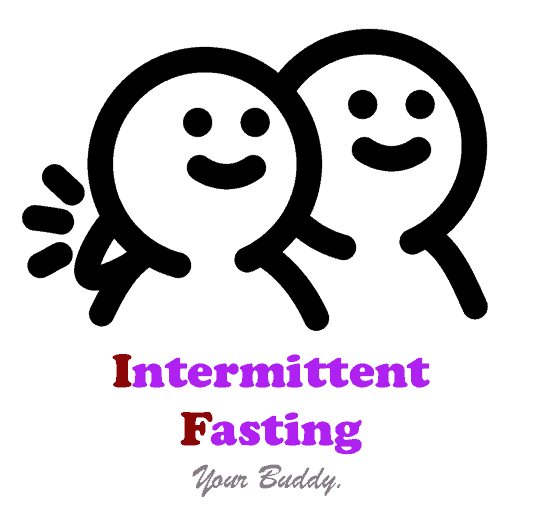Intermittent fasting is a popular diet these days. It is recommended for weight loss, but also its many health benefits. After the age of 40, women start going through various hormonal changes, which may bring a bit more difficulty losing weight. But don’t worry! It’s not a lost battle, on the contrary. Here are the best 5 types of intermittent fasting for women over 40 that will help you stay healthy and in shape.
1. The 16/8 method
This is probably the most popular intermittent fasting method, regardless of age or gender. You eat for 8 hours and fast for the remainder 16. Since you’ll most likely be asleep for 8 out of the 16 hours fasting window, you can understand why it is considered a fairly easy method.
Benefits
- It is easy to follow. There is no recommendation as to when you should fast and when you should eat. That means that if your schedule changes often if you work night shifts, for instance, you can simply adjust your fasting window to suit your needs.
- It can be modified. While most people refer to this as the 16/8 method, so prefer the name “time-restricted fasting”. That’s because you don’t have to feel like you must fast for 16 hours. You can choose a different ratio, such as 14/10 for instance. Some’ll go by something more extreme like 18/6 or even 20/4, though these long fasting periods aren’t recommended for women. The point remains that if you feel 16 hours of not eating is too much for you, especially in the beginning, you can opt for a shorter fasting window.
- It helps with weight loss. Studies show that fasting increases your metabolism, helping you burn more fat throughout the day.
- It improves blood sugar control by reducing fasting insulin levels.
Side effects
Sadly, this intermittent fasting comes with a few risks, especially for women.
- Because you’re skipping at least one meal, there’s a risk of undereating. For this reason, you should always make sure your daily caloric needs are met.
- Unless you’re also eating healthy, weight loss is not guaranteed. Remember fasting doesn’t mean you can eat anything you want in those 8 hours.
- For women, there’s also a risk of hormonal imbalances. Studies suggest intermittent fasting may affect men and women differently, and women specifically could find themselves facing fertility issues or other hormonal imbalances. Since after 40 there’s a natural imbalance that comes with peri-menopause, you may want to pay extra attention to this issue to not make matters worse. Doctors suggest fasting for no longer than 14 hours to avoid hormonal issues. If you want to try it for longer, you should probably consult a physician first.
Daily schedule
Your fasting schedule is going to depend a lot on your day-to-day activities. However, unless you work in shifts, you should try to stick to the same schedule each day. For instance, many find it easiest to skip breakfast and fast until around noon. That means you can eat from 12 p.m. until 8 p.m. giving you time to have lunch, dinner, and 1 or 2 snacks in between.
If you don’t like eating that late in the evening, you might prefer skipping dinner instead of breakfast. In this case, you could have your 8-hour eating window from 9 a.m. to 5 p.m. for instance.
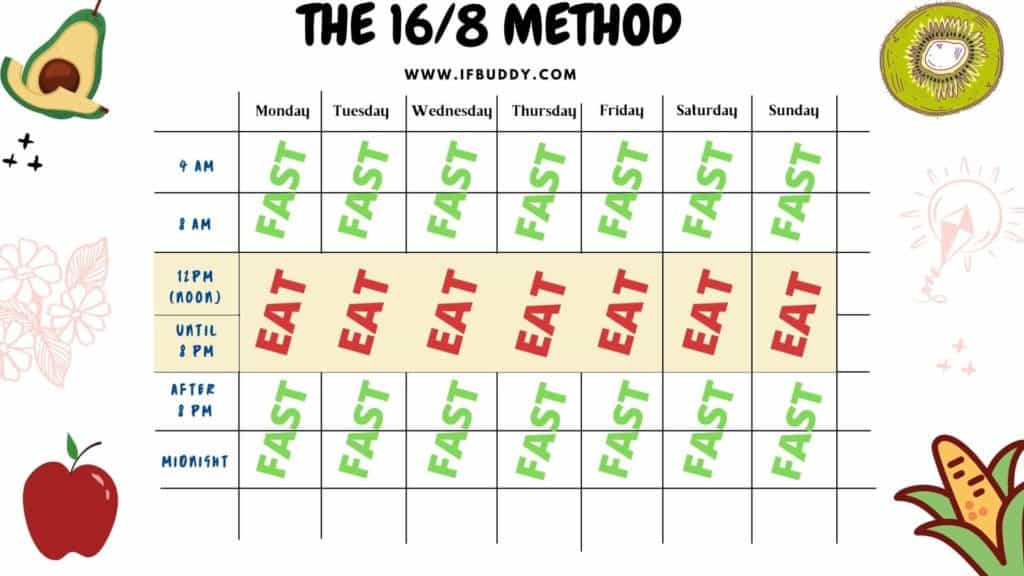
2. Alternate-day fasting
As the name itself suggests it, in this method, you eat normally one day and fast on the next one. In other words, 4 days a week you eat a normal diet, and the other 3 you will eat about 20-25% of your daily caloric needs. Unlike in the previous method, you are not required to completely abstain from food for any number of hours. Sure, eating only 500 calories one day means you’ll likely skip 1-2 meals, but you get to choose which ones, One day you might feel like eating dinner and skipping all the others, the next day you might feel like you want lunch, and so on.
Benefits
Alternate-day fasting has many health benefits proven by several studies.
- It helps manage type 2 diabetes but improving insulin sensitivity.
- It reduces oxidative stress and inflammation in overweight adults.
- It may help reduce hot flashes in perimenopausal women, which makes it a great method of intermittent fasting for women over 40.
- It may also help people suffering from seasonal allergies, heart arrhythmias, asthma, and more.
- It promotes weight loss.
Side effects
While it has many health benefits, the truth is alternate-day fasting can feel like a very restrictive diet. The main concern is the risk of entering the starvation mode, where you not only have difficulty losing weight, you might even start to gain as your body holds on to every single bite of food, as your basal metabolic rate decreases.
Studies, however, show optimistic results. Continuous calorie restriction may lead to a drop in BMR of about 6%, whereas alternate-day fasting leads to a drop of only 1%.
Other possible side effects include:
- insufficient nutrient intake;
- hypoglycemia;
- fatigue;
- difficulty concentrating
Weekly schedule
Your alternate-day fasting schedule is very easy. For instance, you start on Monday and consider it a normal eating day, Tuesday you’ll fast, and Wednesday you’ll eat again. Most recommend you just keep going alternating. Meaning that with this schedule in mind, Sunday would be a normal eating day, so this time, Monday will be a fasting day, and so on.
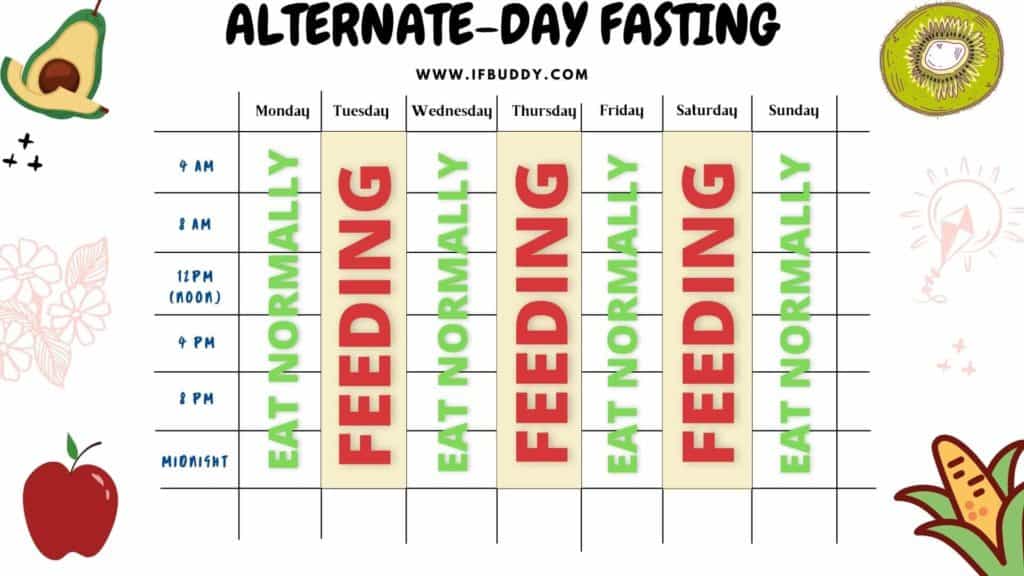
3. The 5:2 method
This is a variation of the alternate-day fasting method, one that many consider a bit easier and more permissive. In short, 5 days a week you eat as you’d like. In the other 2 days, you reduce your calories to 25% of what you were normally eating. Otherwise said, if you normally eat around 2000 calories, on those 2 days you would reduce to only 500 calories a day.
Benefits
There aren’t many studies discussing specifically the 5:2 method, but since it is so similar to alternate-day fasting, many of the same benefits apply and include:
- weight loss, as long as you don’t overeat on the 5 days of normal eating;
- improved insulin sensitivity;
- less frequent hot flashes for women going through perimenopause.
If your main goal is to lose weight, aim to eat a healthy balanced diet on the 5 normal-eating days. Do not restrict your calories, but don’t take it as an invitation to overeat, or binge on junk food, or you will sabotage your efforts.
Side effects
The caloric restriction on the two fasting days is pretty extreme and some people may find it very difficult. If you experience symptoms such as:
- hypoglycemia;
- dizziness;
- fatigue;
- difficulty concentrating;
- feeling cold all the time
it might be a sign this fasting method is not for you.
How to schedule fasting days
For the best results, the two fasting days shouldn’t be consecutive. Try to choose them so that you know you won’t be tempted: days when there are no celebrations at work or home when you know you won’t go out to eat so that you can control more easily what you eat. For most people, those won’t be on the weekend, but of course, it depends on your preferences and your schedule. If you find it easier to fast on days when you are off work, feel free to schedule your fasting days accordingly.
As an example, you could eat normally on Monday, fast on Tuesday, eat normally again on Wednesday and Thursday, fast on Friday, and eat normally during the weekend.
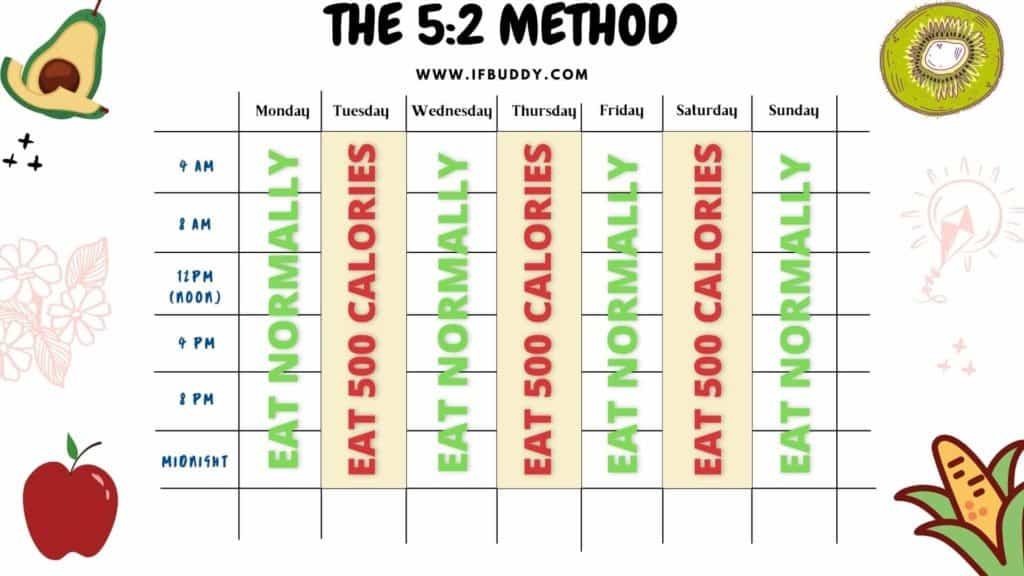
4. The eat-stop-eat method
Similarly to the 5:2 diet, the eat-stop-eat method requires that you fast two days a week. However, if the 5:2 diet recommends consuming about 25% of your daily caloric intake, with this method, you’ll abstain from food completely. Like during the fasting window of the 16/8 method, you’re allowed to drink water or any other unsweetened beverages. Some versions may also allow MCT oil in your coffee, but nothing else.
Benefits
- It can help weight loss. Like with all other intermittent fasting diets, you should avoid overeating though.
- It promotes fat loss by putting you briefly in ketosis, a state where your body uses primarily fat for fuel, instead of glucose.
There are insufficient studies to say whether this extreme calorie restriction, even just on two days a week, impacts women’s hormonal health in any way.
Side effects
- It may lead to nutritional deficiencies.
- There’s a risk of becoming hypoglycemic on fasting days, which requires immediately breaking the fast.
- Overeating and extreme cravings could appear in the non-fasting days.
Choosing your fasting days
Similarly to the 5:2 diet, make sure you don’t fast on consecutive days. Other than that, choose two days when you think it’ll be easiest for you to stick to your fast.
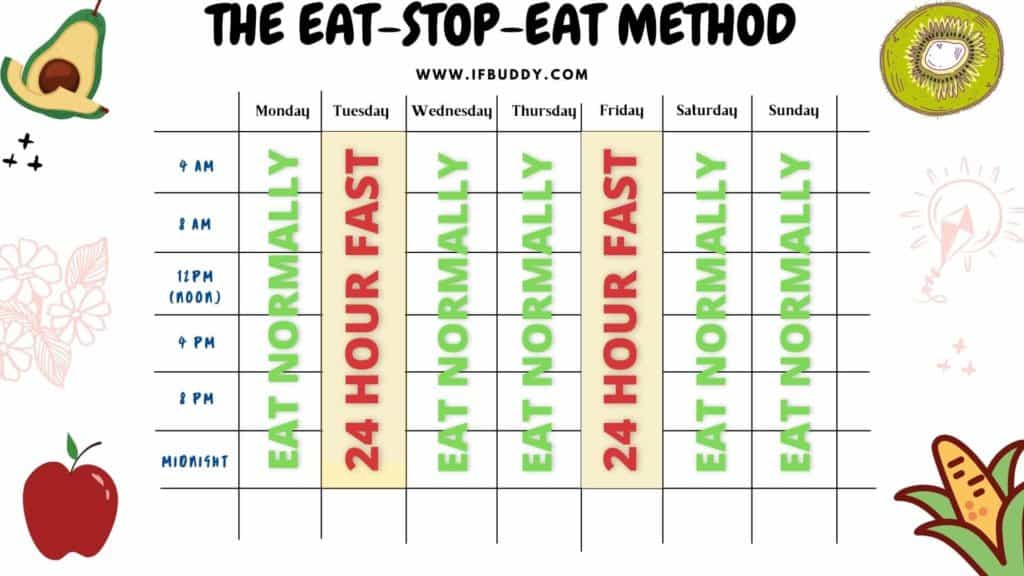
5. Overnight fasting
The final method on our list is probably the simplest one. It is a much shorter and easier version of the 16/8 method: you fast for only 12 hours.
Benefits
Despite fasting for very little time, you still enter autophagy at the 12-hour mark, which means you get to benefit from the cell-renewing benefits any fasting diet has.
There is almost no risk of becoming hypoglycemic or undereating, unless you are, of course, restricting your diet in other ways.
Weight loss may be slower, but you could still achieve it with a healthy diet.
Because it is such a non-restrictive diet, it has no side effects. Any issues that appear will be either due to a poor diet during the eating window or any other health conditions.
Daily schedule
Since you’re eating for about 8 hours of the 12, you only need to worry about fasting 4 hours a day. For instance, if you stop eating 3 hours before bed, let’s say, at 7 p.m., you can have breakfast at 7 a.m. It is a fairly natural schedule for most people and the most you’re required to give up is a bedtime snack.
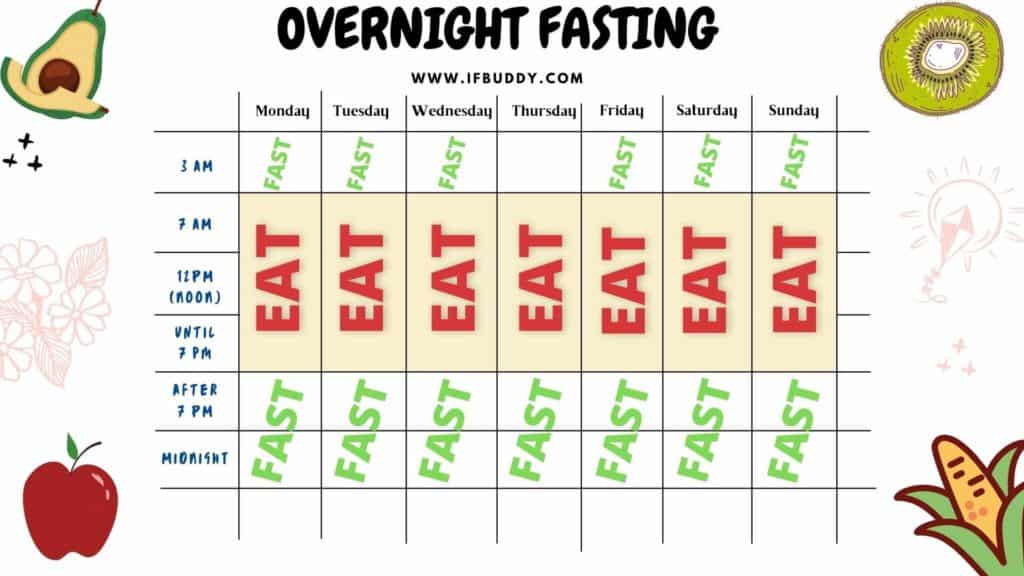
To sum up
Intermittent fasting for women over 40 can be very helpful for those who want to lose weight, manage blood sugar, and more. Some of these diets may lead to hormonal imbalances, so make sure you constantly monitor how you feel and if you have any doubts, speak to your doctor.
If you’re still wondering which one to choose, I’d recommend the 16/8 method. It gives you the most health benefits, and it is the least restrictive, once you get used to the new schedule. And if you find the fasting period is slightly too long you can always shorten it by 1-2 hours. You’ll still have all the benefits of fasting, you’ll still lose weight, though it might be slower. On the bright side, there are fewer risks of side effects.
